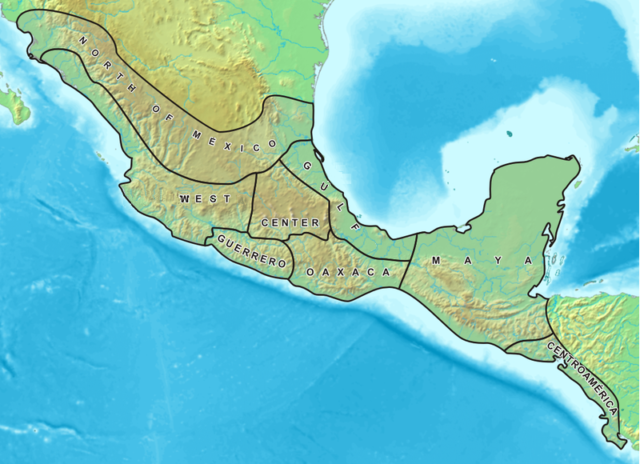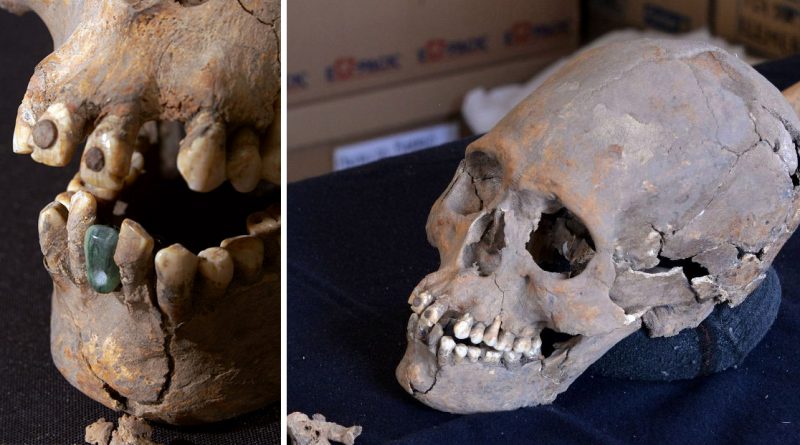Rappers love decorating their teeth with jewels, but it seems like these “original” gangsters took a page out of 1,000-year old Mexican tradition.
Archaeologists have recently unearthed the skeleton of a wealthy woman whose skull was intentionally deformed and her teeth coated with mineral stones. The jewels discovered in the lady’s teeth show that she was either wealthy enough to have rare foreign jewels or that she migrated from a region far outside where she was found.
The unearthing of this skeleton was close to the ancient ruins of Teotihuacan, which is located in a modern day town called San Juan Evangelista.
The age of the woman was likely to be in the late 30s or 40s when she died and was buried with offerings placed in 19 ceremonial jars.
This lady’s remains show that the skeleton was purposely shaped a specific way. The woman’s skull was stretched though a compression in a “very extreme” manner.
This prosthetic technique was commonly utilized in south Mesoamerica, which is a distant land from the one she was buried in. Teotihuacan has been known to have contained its fair share of intentionally modified skulls.
But even though deformed skeletons were common in Teotihuacan, the woman, also known as “The Woman of Tlailotlacan”, stands among the few with such extreme deformation. She was also discovered to have worn a prosthetic created from a green stone called serpentine.
Another distinctive feature, showing the woman was likely a foreigner in Teotihuacan, is that there are two rounded pyrite carvings that were applied on the front of her teeth.
This was a technique often seen across the Mayan regions located throughout Mexico and into Central America. This means that it’s guaranteed the lady had a lengthy journey to the culture she was buried in.
Teotihuacan was a mystical city that was located approximately 30 miles north of modern-day Mexico City. The city thrived from the first century and stayed strong for over eight hundred years. One day, however, its citizens vanished.
Teotihuacan has a deeply-rooted meaning attached to it that indicates that this city was a place where mere men could transform into gods.
It is most well-known for having giant pyramids that represent both the moon and the sun. Teotihuacan culture worshiped eight powerful gods, and was accustomed to hosting ceremonial human sacrifices.
The ancient city was founded 2,500 years ago and was at one point in time one of the largest cities in the world. When the city was suddenly deserted in 700 AD, very little was left from its civilization, and there were even fewer clues as to what sparked the mass migration. In 2010, 100 years have passed since archaeologists began exploring the site.
This tomb was an incredible addition to the excavation site because experts declared that a tomb discovery would show significance in gaining insight into the culture and social structure of Teotihuacan. The burial helped uncover the mysteries that were the Teotihuacan culture.
The city was speculated to have been founded around 100 BC. The city was under continuous construction for the next 350 years. It seems like Teotihuacan was founded as crucial religious epicenter in the Mexican Highlands around two hundred years after the civilization’s establishment.
This city came to be the largest and most populated center in the New World. Teotihuacan was even home to multi-floor apartment compounds built to accommodate this large population. The term Teotihuacan (or Teotihuacano) is also used for the whole civilization and cultural complex associated with the site.
By the time the construction was finished in 250 AD, the city was filled with beautifully crafted major monuments. It is believed that the city thrived until the 7th or even as long as the 8th century AD, but a huge portion of the city may have lasted until sometime between the 7th and 8th centuries AD.

But Teotihuacan saw its major monuments systematically attacked and destroyed in about 550 AD.
The city’s being a religious center is further backed by the deformity of the skulls found near the upper-class woman. In the same way, the Mayans deformed the skulls of children when they were young because it made the deformity easier to mold.
It was believed that the shape made people appear nobler. The shape-shifting was not only aesthetic but also had social purposes accompanied with religious intentions.
It is said that the Mayan ancestors were spoken to by the gods. If the heads of men were formed, they would appear beautiful and noble. It was thought that this head structure allowed the man to better bear burdens.
Although it is a subject of debate whether Teotihuacan was the center of a state empire, its influence throughout Mesoamerica had been known for ages. Evidence of Teotihuacan tradition and culture can be found in multiple sites across the Maya region.
Even the Aztecs claimed a common ancestry to the Teotihuacan civilization, and they went as far as to modify the Aztec culture to resemble Teotihuacan’s. The origins and ethnicity of the Teotihuacan civilization have sparked fierce debate for a century now.
It’s speculated that the inhabitants were of the Nahua, Totonac, or Otomi origin while scholars have also hinted that Teotihuacan truly thrived as a multi-ethnic state.
As the civilization was abandoned, tens of thousands of very valuable objects were left behind as well. Almost 50,000 high-value objects including important stone, jades, shells, and even advanced pottery were thrown into a tunnel before being closed in.
Recently, in another tunnel, a mysterious tomb was discovered in the same region with hundreds of golden orbs. Excavations quickly started and in 2009 archaeologists reached the mouth of the tunnel and excitedly found evidence that they had likely discovered the tomb of a ruler.
The tunnel was believed to be a more dominant element. This central chamber that has been discovered gives hopes to archaeologists who have been studying Teotihuacan. It is likely excavators will soon find more remains of those who ruled Teotihuacan.
There are plenty more discoveries to come over the next couple of years, and major pieces of the social structure and culture of Teotihuacan are yet to be uncovered.
